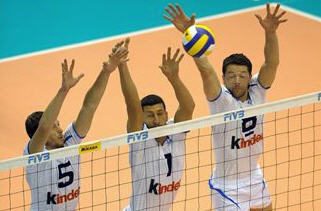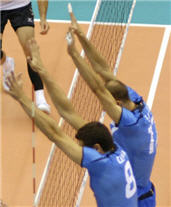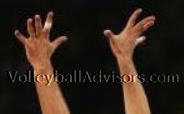Learning Volleyball Blocking - How to Stop the Spiker?
Read about volleyball blocking techniques and how to set up a steady block.How to position your hands and arms when blocking?
How to direct the ball straight into the opponent's court?
Most volleyball coaches and players agree blocking is one other difficult volleyball skill to learn. We go through few simple tips, which help you to stop more balls at the net.

On Volleyball Blocking Drills – How to Practice Blocking?
On the volleyball drills page we give few tips how to practice these blocking skills. Be sure to check them out – there are simple exercises, which help beginning volleyball players to become better blockers.How Beginning Volleyball Players Practice Hand and Arm Position in Blocking?
Probably the best way to learn hand and arm position in blocking is to practice it in a simple drill in which you..- jump
and reach over the net – and crab the ball, which the
assistant holds in
the other side of the net.
- Catch the ball and bring it back into your
own side. When grabbing the ball the hands/arms should be bent forward
- penetrating into the other side of the net. The ball needs to be as
far as possible!
- It is important to
realize the volleyball player should not keep hands/arms straight up
when blocking - they are straightened, but not pointing straight up.
Hand Position
- The assistant needs to place the ball to the
position, which barely
allows the player to grab the ball. It is important HOW the player
grabs
the ball. The player should grab the ball by placing hands
"next to
each others" - just like in blocking.
- To take it to the next level: the assistant needs to move the ball to the left or right to make the player "grab" different shots - line shot, angle shot, etc. This teaches players to turn hands to appropriate direction.
Hand Position in Volleyball Blocking - "Around the Ball"
Two hands should form "a natural grab" around the ball. The optimal block is when you place two hands next to each other and turn them SLIGHTLY "around the ball". When you turn your hands "around the ball" it works better than just putting up "a straight and flat surface". (For example rightside blocker turns the right hand slightly "inside", towards center of the court.)Here are few pictures about hand position:
 In first picture the left side blocker (in the
picture, the player on the right) is placing hands
"around the ball". The blocker's left hand is turned
"inside".
In first picture the left side blocker (in the
picture, the player on the right) is placing hands
"around the ball". The blocker's left hand is turned
"inside". The second picture may exaggerate, but in
blocking you try to "grab" the ball - your goal is to place the hands
"around the ball". Pay special attention to the right hand, the
blocker's hands are not just "a flat surface".
The second picture may exaggerate, but in
blocking you try to "grab" the ball - your goal is to place the hands
"around the ball". Pay special attention to the right hand, the
blocker's hands are not just "a flat surface". The third picture is NOT the
best example of a
block. Hands form a "flat surface", which means you really
can't direct the ball to the desired direction.
The third picture is NOT the
best example of a
block. Hands form a "flat surface", which means you really
can't direct the ball to the desired direction.The hands are also too wide apart, the ball could travel between the hands, "through the thumbs." (Notice! Unless blocking two directions with hands wide apart - as in the picture below.)
Fingers
Fingers need to be widespread and "relaxed", not extremely flexed and tight.


DO NOT tighten up (or flex) your fingers – because you can’t direct the ball like that - and often the ball bounces outside the court even if blocked.
Wrists
Remember to keep your your wrists rigid - against the hard spike you definitely need it!
Volleyball Blocking - Arm Position
Arms should be straightened, but not pointing straight up. You should
bring the arms as far to the other side as possible. The key
for successful blocking is to put
the hands as close to the ball as possible.
When penetrating to the other side of the net, you'll lose height off your block, which is absolutely fine. You should reach as far as possible to the other side - NOT as high as possible.

The left side blocker has an excellent penetration into the other side of the net.
He is setting up a solid block by shrugging the shoulders and keeping his shoulders and core "tight".
Notice how his abs are controlling the body. He is leaning forward with the upper body - his abs are pushing his upper body and arms towards the hitter.
Shoulders
Shrug your shoulders ("lift them up") and keep them strong and solid. Shrugging helps you to reach a little bit higher. Plus you need it against stonger spikes.
Volleyball Blocking Tips for the Smaller Players
Smaller players may not be able to penetrate in order to reach over the net. Often shorter players keep their arms straight up - and bend their hands to block the ball down. When reaching higher like that - the drawback is the ball often bounces off the forearms.Smaller players may choose to "slow down" the ball for the defenders - without trying to block the ball down to the other side.
Blocking Example for the Smaller Players:
 Here
is a great volleyball blocking example about shorter setter blocking.
Here
is a great volleyball blocking example about shorter setter blocking.
The player is not trying to block the ball straight down into the opponent's side, but tries to "get touches" and slow down the ball for the defenders.
Player's hands are NOT angled towards the opponent's court, but hands are bent "backwards". This same style of blocking can be used, if the player is late and doesn't have time to penetrate into the other side.
Volleyball Blocking - Penetrating into the Other Side
Why penetration into the opponent's court is important?First, it helps you to direct the ball straight down to the other side.
Secondly, it brings you closer to the attacker. It is harder for the spiker to hit the ball pass your block when you are closer.
The closer you are, the more you’ll cover your own court. You help your own defenders since the attacker has much smaller area to hit the ball into.
We'll continue with other blocking pages soon..
Like this page:




